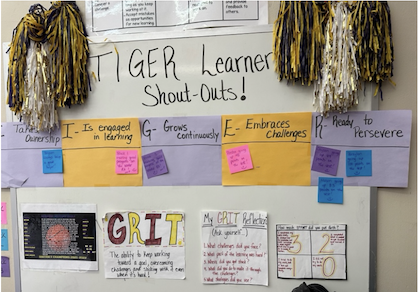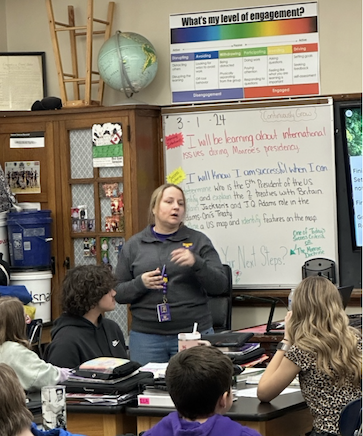Greenfield’s Legacy of Leadership: Honoring the Past, Preparing All Students for the Future

May 2024
The Greenfield Exempted Village School District (GEVSD) strives to develop the whole child1 by providing students with opportunities to develop strong critical thinking and problem solving skills and implementing innovative practices that improve the capacity of the district to meet the instructional needs of every learner.
Located in Highland County in rural southern Ohio, GEVSD is home to approximately 1,950 students, pre- kindergarten through 12th grade, from portions of three counties – Fayette, Highland, and Ross.
The district has five schools – three elementary schools, one middle school, and one high school. It also offers remote options for credit recovery, and some students attend vocational school in the Wilmington area. The population is primarily White (about 93%) with about 60% of the students identified as economically disadvantaged and 14% identified as students with disabilities.
The district’s use of collaborative leadership teams – district leadership team (DLT), building leadership teams (BLTs), and teacher-based teams (TBTs) – along with a focus on teacher clarity (e.g., making learning goals explicit and supporting students to assess their own progress toward those goals), has fostered steady improvements in learning and workforce development for all children and youth.
Forward Thinking Then and Now

Respect for tradition and “Tiger Pride” connects people across the larger community. “We’re the largest employer in town and everybody has a connection to the district. The main campus is really the center of town, literally and also figuratively,” said Quincey Gray, GEVSD Superintendent. “The community support we have here at the school is like none other,” she added.
Community support for the district began many years ago when, in 1915, local businessman and innovator Edward Lee McClain donated the high school – the first in the state to have an indoor pool. “Mr. McClain was an innovator and he was forward thinking at the time. People came from around the country to see it and not only for the design, but for the classes that were offered,” said Alisa Barrett, GEVSD Director of Instruction.

The Edward Lee McClain High School, turning 109 this year, retains its marble staircase and sculptures. In the spirit of innovation that characterized McClain, the high school was the first school in the district to implement a successful one-to-one technology initiative. As stated on the district website, “technology has changed the way teachers teach and children learn. All of the students at McClain High School are using take home 1:1 Chromebooks to access digital materials and cultivate collaboration and creation skills.”
Change is not always met with enthusiasm. “People in the community sometimes feel apprehensive about change and innovation of the facilities, but they greatly support instructional change and growth,” said Gray.
Focus on workforce development. According to Gray and Barrett, the majority of Greenfield’s graduates do not pursue higher education. “People don’t always realize that we don’t have the majority of our students headed to college and that’s one reason we appreciate the changes with the recent graduation requirements,” said Gray.
Ohio’s long-term graduation requirements, which took effect for the class of 2023, require students to complete three components – credit requirements, competency, and readiness – and provide more flexibility for students to meet competency requirements through foundational and supporting options, such as apprenticeships and work-based learning.
“We make steps to prepare our students through a very strong work-based learning program at the high school that is in place for students whose pathway would be best supported with that model. We get them into manufacturing plants and they’re able to stay local,” explained Gray. “GEVSD’s graduation rate is in the high 90s,” she added. The district is committed to meeting the needs of each student including those with significant cognitive delays. “We have one student right now who will stay until she’s 23, and we extend open arms to her because this environment best meets her needs,” said Gray. “We also have a growing number of students being raised by grandparents, and we work hard to support them as guardians,” she added.
Prior to returning to her hometown of Greenfield, Gray spent 13 years in Miami Trace Local Schools and two years in Chillicothe City Schools, serving in various roles (teacher, curriculum director, federal programs director, and principal). She’s been with GEVSD for 11 years – six as an elementary principal and five as superintendent. “I learned a lot in Chillicothe; a lot about children, a lot about families and the kinds of support they need and how to support them, and to watch for biases,” recalled Gray.
Sharing Responsibility for Student Success – In Every Classroom in Every School

GEVSD’s district improvement journey began in 2007 when a school in the district was designated as being in improvement status. “We always had at least one out of five schools in improvement. We were at the secondary conference3 in Columbus and heard Cathy Lassiter speak. I was there with Jason Potts, the then high school principal who is now the middle school principal, and we looked at each other and thought, ‘this is what our district needs,’” explained Barrett.
“Prior to that, any initiative that we had had in the district seemed to be you kind of do it for a year or two, then you move on, and you just keep piling on and so forth,” said Gray. “We were going through the five-step process but we weren’t having deep conversations about instruction,” she added. District leadership at the time was shifting. GEVSD’s superintendent had retired, an interim superintendent was in place, and principals were changing. “The middle school became a focus school, we wrote our school improvement grant focusing on backward design, and I wanted to work with Cathy,” said Barrett. “And so, I talked with Cathy, and the people from the state came in to evaluate the building and identify areas we needed to improve and one of them was the conversations we had within our DLT, BLTs, and TBTs. And so, we knew that needed to be a focus,” she added.
Quincey Gray became superintendent and Ron Sexton, who had served as interim superintendent, became the middle school principal. “That’s when changes started at the middle school,” said Barrett. More focused improvement efforts began in the summer of 2019 when the district began working with Dr. Cathy Lassiter to improve student achievement at the middle school. Lassiter recalls:
“Teacher clarity on the Ohio standards was of paramount importance, along with making the learning process visible to students. Over the years, the work expanded to including all schools in the district implementing the process for teacher clarity, developing assessment-capable learners and creating a culture of feedback. Leaders learned about the change process and held themselves and the staff accountable for implementing these evidence-based practices in every classroom, in every school. Their results over time are validation of their vision, effort and laser focus on continuous improvement.”
The middle school was our starting place and it opened up the door to what we needed at the middle school, but we asked ‘why are we starting in the middle when it should be system-wide,’” said Gray who recalled her experience in a previous district where she described her building as being “by itself and not part of the district.”
“So we put a district plan together that was spearheaded by our DLT. Our DLT is now truly focused on instructional measures but at first we would look at data and really not know what to do with it. We started making connections between student data and adult data and learned that the adult data is just as important; it’s about implementation,” Gray said.

Shared leadership is key. The GEVSD began working through a plan that involved selecting what Gray calls “common learner dispositions” that would be used across the district, and engaging all staff in “common professional learning” about teacher clarity. The pandemic interrupted plans a bit, but leadership continued planning, talking with Lassiter about what teachers and principals needed. “A key to where we are now is building our schools up as instructional leaders and ensuring that all of our principals are part of the DLT,” said Barrett.
Part of GEVSD’s use of making learning visible is the commitment of leadership to also be learners and participate in professional learning. “A part of our visible learning piece is that it’s not just teachers receiving professional learning; it’s also administrators. We’re transparent with the teachers that they’re not the only learners and that it’s us as well,” said Jason Potts, Principal of Greenfield Middle School.
Visible learning, according to John Hattie, means that all students are able to see and understand how their efforts contribute to their learning, and that teachers engage in self-evaluation with a focus on how well their students are learning (Hattie, 2023).
GEVSD focused on several high-impact strategies, as identified through Hattie’s meta-analyses, including improving teacher clarity, developing assessment- capable learners, and providing effective feedback focused on improved teaching and learning. According to the Missouri Educational Systems and Instruction for Learning (MO EDU-SAIL):
Assessment-capable learners understand what they are supposed to learn, monitor their own progress, set goals, and reflect on their learning. Assessment-capable learners are students who know the learning target for a lesson, can describe where they are in relation to the criteria, and use that information to select learning strategies to improve their work.
All Classrooms in All Schools. The benefits of the district’s work to improve teaching and learning, and to stay the course over the past five years, are becoming evident. “This is our first year since 2007 without any school improvement designations,” said Gray. “Part of our success has been the constant communication from the DLT to the BLT and TBTs, and back up. This is not just a top-down approach,” said Barrett.
In addition to all principals, GEVSD’s DLT includes assistant principals, teachers, and central office leadership. “We try to have a 50-50 split of teachers and administrators to make sure it’s not administrator- heavy,” said Barrett.

According to Potts, the biggest challenge to implementing any initiative is getting staff buy-in. “You have to get people on board before you’re going to move anything. Our biggest step was implementing with fidelity,” he said. Potts and Assistant Principal Jeremy Andrews routinely walk through every classroom in the middle school to “check on learning intentions, success criteria, and group norms and aspects.” “Follow through has been extremely key,” offered Potts.
As important, when teachers transfer to schools within the district, they understand the process and are entering an environment that is focused on implementation of the same high-impact practices (e.g., developing assessment-capable learners). “It’s district-wide and we’re all on the same page. So, I don’t care if a teacher goes from here to there, she still understands the process,” said Potts.
Another important factor in GEVSD’s success has been the focus on consistent implementation and constant evaluation of impact on a districtwide basis. Due to a large group of retirees, Potts began the school year with turnover of a third of the middle school staff, the majority of whom were teachers. He said, “hiring 15 new staff members this year was a challenge. The question was how do I get that many people on board and up to par as quickly as possible?”

Potts assigned four of his most senior teachers to provide teacher-to-teacher support, visiting new teachers every day for a period and providing them with feedback on what improvements were needed to support implementation of selected practices (e.g., teacher clarity). “When a teacher talks to a teacher, you’re going to have more buy-in and we were able to catch them up quicker than if Jeremy and I had done it,” explained Potts.
Being Present. Other learning from GEVSD’s improvement journey involves the importance of district and school leadership leading the work. “The superintendent needs to be involved; I need to be involved,” said Gray. “And it’s not just bringing in a consultant and letting them do all the work. I feel that’s something different that we did than what we had done with other initiatives in the past. This is just a different level of being present,” she added.
Another shift in practice involves using evaluation to reinforce practice aligned with district priorities. In the past, principal evaluation as required by the Ohio Principal Evaluation System (OPES 2.0) was more of a perfunctory activity. Now, it’s used to leverage the use of high-impact practices identified by the district.
Gray explains:
“When I was principal here for six years, evaluation was more of a compliance activity. Now, when we present about the work we’re doing , for example, at the OSBA conference, other districts ask ‘how do you get your principals to do that?’ “My expectation is for principals to implement with fidelity and I evaluate them. My principals are instructional leaders and they have self-efficacy within themselves, too. They want their building to be the best even though we’re all on the same team!”
Potts agreed: “We do want to be the best! I know what I’m shooting for.” “We know what we’re shooting for,” said Barrett. Collaboration between and among principals and schools was something the district worked hard to achieve. “When I first started in the district, there was no director of instruction; everyone was just flying by the seat of their pants. The elementaries were almost pitted against each other,” stated Barrett.

“Now, we have good relationships with teachers across the elementary schools. So much of that came from the DLT,” said Barrett who recalled early conversations with teachers. “They were painful and there were meetings where you sat and didn’t talk,” she said.
All Voices Matter. District leadership persevered and the GEVSD DLT includes about 10 teachers with each school represented. The district continuously examines its own practice to ensure all voices are present. “At one point we didn’t have any intervention specialist voice on the DLT,” said Gray. “So the DLT decided we have to have a special education voice and we added one elementary and one secondary intervention specialist.”
GEVSD uses the DLT to advance focused work aligned with district-identified priorities. “We’ve grown to not be afraid to have those tough conversations to push the work forward and not settle,” explained Gray. “There were many times we would have data conversations across the district and it was always excuses. Well, it’s the parents’ fault, or we can’t impact graduation, etc.,” offered Barrett.
The district focuses on what they can control in order to improve learning and outcomes for all students. “We’ve used the Five Whys4 as a tool, have a lot of small-group conversation, and have members meet in vertical groups to ensure vertical alignment,” Barrett explained.
Setting the direction, staying focused, and engaging all staff have contributed to a culture of mutual respect and fostered continuous districtwide improvement on behalf of all children. “It’s important that we have consistency within and across buildings and stay focused on the district,” said Gray.
References
Buckeye Association of School Administrators (BASA). (2022). Ohio's leadership development framework (3rd ed.). https://ohioleadership.org/storage/ocali-ims-sites/ocali-ims-olac/documents/13073-OLAC-Book-2021-WEB.pdf
Fry, N., Hattie, J., & Fisher, D. (2018). Developing assessment-capable visible learners grades K-12. Corwin.
Hattie, J. (2023). Visible learning: The sequel. A synthesis of over 2,100 meta-analyses relating to achievement. Routledge.
Missouri Educational Systems and Instruction for Learning (MO EDU-SAIL). Missouri Department of Elementary and Secondary Education. Retrievable from https://www.moedu-sail.org/dacl.
Ohio Principal Evaluation System (OPES 2.0). (2021). Ohio Department of Education and Workforce. Retrievable from https://dam.assets.ohio.gov/image/upload/sboe.ohio.gov/Educator-Evaluations/PrincipalEvaluations/OPES-2-0-Model.pdf
For More Information
For more information about the Greenfield EV School District’s improvement efforts, contact:
- Quincey Gray, Superintendent, at quincey.gray@greenfieldmcclain.org.
- Alisa Barrett, Director of Instruction, at alisa.barrett@greenfieldmcclain.org.
For more information about resources to support districts, contact:
- OLAC Director Mike Trego at trego@basa-ohio.org, or
- OLAC Consultants Jim Gay, PhD at jimgay@basa-ohio.org or Karel Oxley at Oxley@basa-ohio.org.